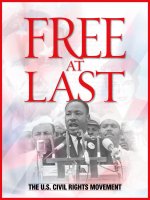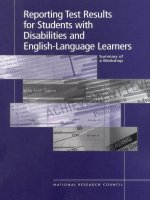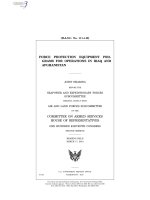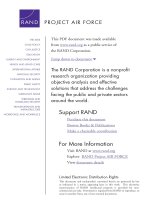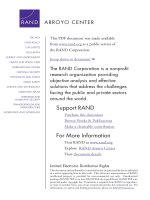the deacons for defense armed resistance and the civil rights movement
Bạn đang xem bản rút gọn của tài liệu. Xem và tải ngay bản đầy đủ của tài liệu tại đây (3.55 MB, 372 trang )
The Deacons for Defense
The Deacons
armed
resistance
and the
civil rights
movement
Lance Hill
for Defense
The University of North Carolina Press Chapel Hill and London
∫ 2004 The University of North Carolina Press
All rights reserved
Manufactured in the United States of America
Designed by Jacquline Johnson
Set in Charter by Keystone Typesetting, Inc.
The paper in this book meets the guidelines for
permanence and durability of the Committee on
Production Guidelines for Book Longevity of the
Council on Library Resources.
Library of Congress Cataloging-in-Publication Data
Hill, Lance E. (Lance Edward), 1950–
The Deacons for Defense : armed resistance and
the civil rights movement / Lance Hill.
p. cm.
Includes bibliographical references and index.
isbn 0-8078-2847-5 (alk. paper)
1. Deacons for Defense and Justice—History.
2. African American civil rights workers—
Louisiana—Jonesboro—History—20th century.
3. Self-defense—Political aspects—Southern
States—History—20th century. 4. Political
violence—Southern States—History—20th century.
5. Ku Klux Klan (1915– )—History—20th century.
6. African Americans—Civil rights—Southern
States—History—20th century. 7. Civil rights
movements—Southern States—History—20th
century. 8. Southern States—Race relations.
9. Louisiana—Race relations. 10. Mississippi—Race
relations. I. Title.
e185.615.h47 2004
323.1196%073%009046—dc22 2003021779
0807060504 54321
For Eileen
Contents
Acknowledgments ix
Introduction 1
1 Beginnings 10
2 The Deacons Are Born 30
3 In the New York Times 52
4 Not Selma 63
5 On to Bogalusa 78
6 The Bogalusa Chapter 96
7 The Spring Campaign 108
8 With a Single Bullet 129
9 Victory 150
10 Expanding in the Bayou State 165
11 Mississippi Chapters 184
12 Heading North 216
13 Black Power—Last Days 234
Conclusion: The Myth of Nonviolence 258
Notes 275
Bibliography 335
Index 353
A section of photographs appears after p. 107.
Acknowledgments
i first learned of the Deacons for Defense and Justice
while attending a meeting of activists in Plaquemines Parish, Louisiana, in
1984. I had moved to rural Louisiana in 1979 and initially worked not far
from Bogalusa as a welder and an industrial organizer. At the meeting in
Plaquemines Parish—once the stronghold of arch-racist Leander Perez—I
met one of the founders of the Deacons, Frederick Douglas Kirkpatrick.
From my first meeting with Kirkpatrick, I decided that the history of this
remarkable group of courageous men needed to be told.
Several people offered thoughtful and stimulating reactions to this book
and deserve a great deal of thanks. Foremost is Lawrence N. Powell, for his
indispensable advice, perceptive criticism, and steadfast encouragement.
Adam Fairclough, Michael Honey, and Tim Tyson provided challenging criti-
cisms and invaluable advice, which greatly benefited the final manuscript.
Patrick Maney, Rosanne Adderley, and Kim Harris all read earlier drafts and
offered many useful and illuminating insights. I have also learned much
from long conversations over the years with my colleague Plater Robinson.
Tulane University’s History Department made my research possible
through several teaching assistantships and travel and research grants. I am
especially indebted to Gwendolyn Midlo Hall for her professional assistance
and expansive generosity. Gwen allowed me to consult her research papers
on the Deacons for Defense and Justice at the Amistad Research Center, and
has been an endless source of information on the left and black nationalist
movements. Many friends and archivists aided me in obtaining materials,
among them Tyler Bridges, Katherine Nachod, Annie Purnell Johnson, and
Brenda Square. David Perry, Paula Wald, and Stevie Champion at the Uni-
versity of North Carolina Press made this book possible through their wise
advice and skillful editing.
Writing a book about a semiclandestine organization poses some unique
problems. The Deacons left no written records, and save for the fbi files and
news reports, the real history of the organization resides in the collective
x Acknowledgments
memories of its members. This book would not have been possible had it not
been for the members of the Deacons for Defense and Justice who shared
with me their stories and wisdom.
My three children, Lisa, John, and Joel, admirably suffered a father who
spent too many sunny days hunched over a dimly lit keyboard. My grandson
Cody Robertson was an inspiration through his love of history—and diesel
trucks. And my parents, Herbert and Gaye Hill, have always been accepting
and supportive through trying times. Finally, I am deeply grateful to my
wife, Eileen San Juan, who has provided years of intellectual companionship
and moral support, and lent her critical eye to reading this manuscript. I
have dedicated the book to her, though such a symbolic act is a pittance for
her love and encouragement.
The Deacons for Defense
Introduction
paul farmer had brought his pistol. The president of
the Washington Parish White Citizens Council was standing in the middle of
the street along with several other members of the council and the local Ku
Klux Klan. It was the autumn of 1966 in the small paper mill town of Boga-
lusa, Louisiana.
Royan Burris, a black barber and civil rights leader, knew why the Klans-
men were there. They were waiting for the doors to open at Bogalusa Junior
High. The school had recently been integrated, and white students had been
harassing and brutalizing black students with impunity. ‘‘They were just
stepping on them, and spitting on them and hitting them,’’ recalled Burris,
and the black students ‘‘wasn’t doing anything back.’’ In the past Burris had
counseled the black students to remain nonviolent. Now he advised a new
approach. ‘‘I said anybody hit you, hit back. Anybody step on your feet, step
back. Anybody spit on you, spit back.’’
∞
The young black students heeded Burris’s advice. Fights between black
and white students erupted at the school throughout the day. Now Paul
Farmer and his band of Klansmen had arrived with guns, prepared to inter-
vene. Their presence was no idle threat; whites had murdered two black
men in the mill town in the past two years, including a sheriff’s deputy.
But Farmer had a problem. Standing in the street, only a few feet from the
Klan, was a line of grim, unyielding black men. They were members of the
Deacons for Defense and Justice, a black self-defense organization that had
already engaged the Klan in several shooting skirmishes. The two groups
faced off: the Klansmen on one side, the Deacons on the other.
After a few tense moments the police arrived and attempted to defuse the
volatile situation. They asked the Deacons to leave first, but the black men
refused. Burris recalled the Deacons’ terse response to the police request.
‘‘We been leaving first all of our lives,’’ said Burris. ‘‘This time we not going in
peace.’’ Infuriated by the Deacons’ defiance, Farmer suddenly pulled his
pistol. In a reflex response, one of the Deacons drew his revolver, and in an
2 Introduction
instant half a dozen pistols were waving menacingly in the air. Surveying the
weapons arrayed against them, the Klansmen grudgingly pocketed their
own guns and departed.
≤
The Deacons for Defense and Justice had faced death and never flinched.
‘‘From that day forward,’’ said Burris, ‘‘we didn’t have too many more
problems.’’
≥
In 1964 a clandestine armed self-defense organization formed in the black
community in Jonesboro, Louisiana, with the goal of protecting civil rights
activists from the Ku Klux Klan and other racist vigilantes. After several
months of relatively secret operations, the group publicly surfaced in Febru-
ary 1965 under the name ‘‘Deacons for Defense and Justice.’’ By the end of
1966, the Deacons had grown to twenty-one chapters with several hundred
members concentrated in Louisiana and Mississippi. The Deacons guarded
marches, patrolled the black community to ward off night riders, engaged
in shoot-outs with Klansmen, and even defied local police in armed con-
frontations. When the u.s. Justice Department faltered in enforcing the
Civil Rights Act, the Deacons’ militant politics and armed actions forced
a pivotal showdown in Bogalusa between the government and southern
segregationists.
Although the Deacons began as a simple self-defense guard to compensate
for the lack of police protection, they soon developed into a highly visible
political organization with a clear and compelling alternative to the pacifist
strategies promoted by national civil rights organizations. They were not the
first blacks to practice or advocate armed self-defense. Throughout the civil
rights movement, African Americans frequently guarded themselves and
their communities against vigilante assaults. But until the Deacons emerged,
these armed self-defense efforts were almost always conducted by informal
and disconnected covert groups that avoided open confrontations with au-
thority and purposefully eschewed publicity—in part because they feared
retaliation and in part because they wanted to maintain the illusion of non-
violence in the movement. It was this public image of a nonviolent move-
ment that ensured white liberal support in the North. Civil rights leaders and
activists also concealed armed self-defense for the same reasons. During the
Montgomery Bus Boycott, one visitor to Martin Luther King’s home was
alarmed to find an ‘‘arsenal’’ of weapons and discovered that King himself
had requested gun permits for his bodyguards. Yet publicly King adamantly
opposed any open, organized armed self-defense activity. Similarly, Sally
Belfrage, a northern volunteer in the Mississippi movement, deliberately
omitted reference to armed self-defense in her memoir Freedom Summer
Introduction 3
(1965). One local black activist in Mississippi had bluntly warned her, ‘‘If you
write about the guns, we’ll kill you.’’ She took his advice.
∂
Invisible to the broader public, clandestine self-defense groups had little
effect on the Ku Klux Klan or federal policy in the South. The Deacons, in
contrast, consciously built a highly public, regional organization that openly
defied local authorities and challenged the Klan—something that neither
the Klan nor Washington could ignore. The Deacons boldly flouted the age-
old southern code that denied blacks the right of open and collective self-
defense, and by doing so they made an implicit claim to social and civil
equality. By the summer of 1965 the Deacons for Defense had developed
chapters throughout the South and generated considerable national pub-
licity through major news stories in Life magazine, the New York Times, the
Wall Street Journal, and the Los Angeles Times. Stories in Newsweek, Time,
Nation, and Business Week followed in 1966. Influential black publications
like Ebony carried the Deacons’ story into thousands of black households,
along with a widely read series of articles that appeared in Jet magazine—
the premier weekly for the African American working class. Within a few
months of their birth, the Deacons had become the talk of the movement
and folk heroes to legions of African Americans in the Deep South. The
publicity propelled the Deacons into the center of a national debate on the
effectiveness of nonviolent direct action, and very soon they were at logger-
heads with Dr. Martin Luther King Jr. and the mainstream nonviolent civil
rights organizations.
∑
Not alone in their disenchantment with passive resistance, the Deacons
reflected a growing disillusionment of working-class blacks with the paci-
fistic, legalistic, and legislative strategies proffered by national organiza-
tions. Many African Americans, men in particular, refused to participate in
nonviolent protests because they believed that passive resistance to white
violence simply reproduced the same degrading rituals of domination and
submission that suffused the master/slave relationship. Moreover, many
African Americans regarded passive resistance and love for one’s oppressor
as dubious antidotes for immobilizing fear and resignation. The fissure be-
tween civil rights leaders and their rank and file loomed large: by the sum-
mer of 1963 a Louis Harris poll showed that 22 percent of black respondents
said that they thought they would have to resort to violence to win their
rights—five times the percentage of black leaders polled. Moreover, a major-
ity of those surveyed believed that blacks would win in this violent show-
down with whites.
∏
The Deacons were a unique phenomenon among civil rights groups—the
only independent working-class–controlled organization with national aspi-
4 Introduction
rations to emerge during the civil rights movement in the Deep South and
the only indigenous African American organization in the South to pose a
visible challenge to Martin Luther King and the nonviolent movement ortho-
doxy.
π
The Deacons were not the first organization to publicly defy the
strictures of nonviolence—Robert F. Williams had pioneered the strategy
several years earlier in Monroe, North Carolina, when he converted a local
National Association for the Advancement of Colored People (naacp) chap-
ter into a redoubt for armed self-defense. But when the national naacp
drummed Williams out of the organization—with the help of Martin Luther
King—he was left without an organizing framework. A riot in Monroe in 1961
caused Williams to flee to Cuba and ended his organizing days inside the
United States. The Deacons took a different tact: they formed their own
organization outside the mainstream nonviolent groups and mounted a vig-
orous campaign to expand it throughout the South.
∫
Reflecting class tensions within the African American community, the
Deacons spearheaded a working-class revolt against the entrenched black
middle-class leadership and its nonviolent reform ideology. In small towns
throughout Louisiana, the Deacons assailed the traditional naacp leaders, a
social stratum forged in the old economic order of agricultural dependency
and habituated to the politics of accommodation and tactical legalism. They
were emblematic of the newly industrialized southern economy that had
called into existence a black working class that was no longer the captive of
sharecropper servitude. Their political strategy was confrontational, dis-
dainful of nonviolence, and independent of white liberal control.
The Deacons were born in response to two significant developments in
1964: the emergence of a well-organized racist militia—the Ku Klux Klan—
and the federal government’s appalling failure to enforce the Civil Rights Act
and uphold basic constitutional rights and liberties in the South. The Klan’s
resurgence in 1964 was a direct result of the failure of the Citizens Councils
of America. Beginning with the u.s. Supreme Court’s 1954 school desegrega-
tion decision, the Citizens Councils, dominated by respectable white civic
and business leaders, led the opposition to integration efforts across the
South. The Councils preferred legal and legislative strategies to violence and
terror. But by the 1960s many ardent segregationists regarded the Councils’
law-abiding and electoral strategy as an ignominious defeat; the Councils
had failed to hold the line against the Yankee invaders.
Ω
By 1964 the deteriorating position of the Councils and other old-line
segregationists, coupled with the implementation of the Civil Rights Act,
sparked a spectacular growth of Klan organizations that advocated terrorist
violence and direct action to thwart enforcement of the new law.
∞≠
In towns
Introduction 5
with large black working-class communities—independent of the old agri-
cultural elite—terrorist violence replaced economic threats as the princi-
pal means of social control over blacks. Throughout slavery and Jim Crow,
violence had been a major coercive instrument for maintaining white su-
premacy, and there was little reason to expect that African Americans could
successfully avail themselves of the new civil rights laws as long as white
violence went unchecked.
The rise of white supremacist violence in response to desegregation made
armed self-defense a paramount goal for many local black organizing ef-
forts. Beginning in 1960, the Deep South states blatantly ignored federal
authority and openly flouted the Constitution and Bill of Rights. Civil rights
activists were routinely beaten and illegally imprisoned with impunity. The
First Amendment right of free expression disappeared into the smoke of
burning crosses. By 1965 the Ku Klux Klan had, through a well-organized
terrorist war, carved out a virtual ‘‘Klan nation’’ in southwestern Mississippi
and neighboring southeastern Louisiana—often with the complicity of state
and local law enforcement agencies. Within this territory a highly organized
and well-disciplined Klan organization fought a successful guerrilla war to
defend white caste privilege. The Klan governed the territory on all matters
of race. They mobilized thousands of supporters, conducted scores of suc-
cessful boycotts, published their own newspapers, and staged coups against
recalcitrant local governments. It was manifest that there would be no racial
progress in this region unless African Americans could devise a stratagem to
break the back of white terror.
∞∞
A full year after passage of the 1964 Civil Rights Act, the Klan’s terror
campaign had succeeded in preventing enforcement of the law in the Deep
South, and most small communities remained rigidly segregated in all pub-
lic accommodations. President Lyndon Johnson, fearing a political backlash
in the South, had avoided a showdown with southern law enforcement and
the Klan. ‘‘Covenants, without the Sword, are but Words,’’ said Thomas
Hobbes, ‘‘and of no strength to compel a man at all.’’ The Sword of the
Covenant was nowhere to be found in the Deep South. And so the final act
of the civil rights movement had been written, complete with a cast of
menacing night riders, derelict sheriffs, dawdling federal authorities, and
vulnerable African Americans. The fatal limits of nonviolence would soon
become clear.
∞≤
Nonviolence is at the center of the Deacons’ story. Much of the popular
history of the civil rights era rests on the myth of nonviolence: the percep-
tion that the movement achieved its goals through nonviolent direct action.
The myth posits that racial inequality was dismantled by a nonviolent move-
6 Introduction
ment that awakened the moral conscience of white America. In this narra-
tive Martin Luther King Jr. serves as the ‘‘moral metaphor’’ of the age while
black militants—advocates of racial pride and coercive force—are dismissed
as ineffective rebels who alienated whites with Black Power rhetoric and
violence.
∞≥
Recent accounts take issue with the idea that the movement relied on
moral suasion, instead arguing that King and other civil rights leaders never
placed much stock in Mohandas Gandhi’s theory of redemptive suffering—
the idea that if one suffered racist violence through nonviolent resistance,
one could eventually change the hearts and minds of racists. These narra-
tives argue that, even if King began his career believing that black suffering
would awaken a sense of ‘‘moral shame’’ in white southern racists, he quickly
came to terms with the political limitations of nonviolence and abandoned
the strategy. The idealistic pacifist became a hard-nosed pragmatist and
turned to a strategy that combined nonviolent tactics with direct action
protest—winning reforms through coercion rather than persuasion.
∞∂
The truth is that King never abandoned his overriding strategy of moral
suasion: he did, however, change his target audience. By 1963 King had
given up any hope of appealing to the conscience of the white South and
instead turned exclusively to the North for his moral appeals. This strategic
course placed white liberals and armed self-defense at the center of a con-
flict that would deeply affect the evolution of the Deacons for Defense.
From the beginning of the modern civil rights movement, opposition to
black armed self-defense was an article of faith for national organizations,
including King’s Southern Christian Leadership Conference (sclc), the
naacp, the Congress on Racial Equality (core) and the Student Nonviolent
Coordinating Committee (sncc)—though sncc and core moderated their
official positions near the end of the movement. By opposing armed self-
defense, the national civil rights organizations often placed themselves
on a collision course with local movements. There were significant differ-
ences between the goals and strategies of national and local organizations
and campaigns. Locally controlled movements frequently focused on imme-
diate efforts to gain power over segregation, economic needs, and govern-
ment services. And unrelenting police and vigilante terror compelled local
movements to give substantial time and resources to counter violence and
intimidation.
∞∑
In contrast, the national organizations were guided by the thinking that
racial inequality—social, economic, and political—could be remedied only
by national legislation that removed the civil barriers of segregation and
discrimination. This civil rights legislation would be won by coalescing
Introduction 7
with northern liberals and applying pressure on Congress and the president.
White liberals became an indispensable ally for the national civil rights
organizations—for legislative reform as well as movement funding. King
held to his belief that northern white liberals (and, to some degree, trade
union leaders) could be morally persuaded to support the civil rights move-
ment. Toward this end, he sought to gain their sympathy by employing
tactics that provoked and exposed the raw white violence that lay under the
surface of southern life. The strategy wielded both coercion and moral sua-
sion: coercion against southern whites to create the circumstances for moral
suasion in the North.
∞∏
But winning the sympathy of whites unavoidably meant appeasing white
fears of black violence. In the 1950s many northern whites retained old ste-
reotypes of blacks as violent, vengeful, and impulsive. They believed that
blacks lacked internal psychological constraints and self-discipline, and that
they were incapable of forgiveness and generosity. King was acutely aware of
these white fears of violence, and in his first and most important book, Stride
toward Freedom, published in 1958, he adamantly argued that the civil rights
movement had to adopt nonviolence if it wanted to win over northern
whites. ‘‘Only through a nonviolent approach can the fears of the white
community be mitigated,’’ argued King. ‘‘A guilt-ridden white minority lives
in fear that if the Negro should ever attain power, he would act without
restraint or pity to revenge the injustices and brutality. . . . Many white men
fear retaliation. The job of the Negro is to show them that they have nothing
to fear, that the Negro understands and forgives and is ready to forget the
past.’’ To underscore his point, King counseled blacks not to defend them-
selves against Klan assaults and bombings, but to wear down whites through
redemptive suffering: ‘‘Bomb our homes and threaten our children; send
your hooded perpetrators of violence into our communities and drag us out
on some wayside road, beating us half dead, and we will still love you. But
we will soon wear you down by our capacity to suffer.’’ If the Klan bombed
one home, King urged blacks to submit themselves by the hundreds to more
bombings until the terrorists, ‘‘forced to stand before the world and his God
splattered with the blood of his brother . . . will call an end to his self-
defeating massacre.’’
∞π
Sadly, that day of penitence never came for the inveterate racists. But
King’s early pronouncements on the importance of nonviolence in maintain-
ing the black/liberal coalition set the course for the national movement in
the years that followed. King continued to rely on a strategy that required
blacks to suffer white violence to win liberal sympathy. During the 1965
Selma campaign King said that the movement was forcing its ‘‘oppressor to
8 Introduction
commit brutality openly—in the light of day—with the rest of the world
looking on’’ and that white violence in Selma would lead ‘‘Americans of
conscience in the name of decency [to] demand federal intervention and
legislation.’’ The movement could not afford to alienate whites. ‘‘We can’t
win our struggle with nonviolence and cloak it under the name of defen-
sive violence,’’ King said in criticizing the Deacons. ‘‘The Negro must have
allies to win his struggle for equality, and our allies will not surround a
violent movement.’’ Using force against the Klan ‘‘would only alienate our
allies and lose sympathy for our cause.’’
∞∫
The position of a civil rights organization on armed self-defense became
the litmus test for white liberal support. For an organization to embrace
collective self-defense—a right that was taken for granted by whites—was
to risk losing critically needed liberal funds and jeopardize the tenuous
coalition with northern whites. Not surprisingly, the task of moral suasion
ultimately determined the overarching strategy of the national civil rights
movement. Major strategic initiatives were measured against the ability to
win or retain white northern allies. It was a strategy that had its detractors in
the African American community from the beginning. In the 1930s black
moderates and conservatives first trumpeted Gandhian nonviolence in an
effort to undermine the considerable appeal of Marxism among young
blacks.
∞Ω
In the 1960s many critics suspected that the partisans of non-
violence once again had ulterior motives; that the exotic philosophical im-
port from the East was merely a method of candy-coating the black revo-
lution to make it palatable to white liberals. Noted black writer Lerone
Bennett was among the skeptics. The dilemma for blacks, according to Ben-
nett, was to oppose power but not appear to be rebelling against the status
quo. ‘‘The history of the Negro in America,’’ wrote Bennett in 1964, ‘‘. . . has
been a quest for a revolt that was not a revolt—a revolt, in other words, that
did not seem to the white power structure as a revolt.’’ Martin Luther King
had solved the dilemma, Bennett said, by ‘‘clothing a resistance movement in
the comforting garb of love and forgiveness.’’
≤≠
Nonviolence was ultimately a coalition-based legislative strategy cloaked
as religion. In their attempt to assuage white fears of black violence, the
national organizations took a stand against self-defense that placed them at
odds with local movements besieged by police and Klan violence and hob-
bled by passive stereotypes. By giving the luster of religious precept to a
pragmatic stratagem to attract white liberals—while accommodating liberal
fears of black violence—the national civil rights leadership took the high
moral ground and made their critics look like nihilistic advocates of vio-
lence. In truth, defense groups like the Deacons used weapons to avoid
Introduction 9
violence. And they raised important and legitimate questions about a strat-
egy that pinned its hopes on liberals, organized labor and the federal govern-
ment. core activist Lincoln Lynch summed up the doubts of the dissenters
from nonviolence: ‘‘History has shown that if you’re really depending on the
vast majority of whites to help, you’re leaning on a very broken reed.’’
≤∞
The Deacons came to see nonviolence as a ‘‘broken reed’’ strategy that
offered little support or protection. The nonviolent strategy had its strengths
and made enormous accomplishments, but they came at a high price for
many African American men in the South. This is not to second-guess the
choices made by national civil rights organizations, but to understand the
limitations of nonviolence and how it shaped the ultimate outcome of the
movement—and continues to affect American racial politics to this day.
≤≤
The escalating attacks by the Ku Klux Klan in 1964 thrust the Deacons for
Defense and Justice into the middle of a national debate on nonviolence.
More than a defense group, the Deacons grew into a symbolic political orga-
nization that played a key role in the battle against nonviolent movement
orthodoxy. They represented the black working class’s fledgling attempt to
create a new black consciousness. They preached self-reliance rather than
dependence on the government for rights and freedom; they sought reform
by force and coercion rather than by pacifism and moral suasion; and they
repudiated the strategy of winning white approbation through suffering.
Freedom was to be won through fear and respect, rather than guilt and pity.
In short, they believed that to be free blacks had to act free.
≤≥
chapter
1
Beginnings
earnest thomas had been a fighter all his life. Born in
Jonesboro, Louisiana, on 20 November 1935, Thomas was descended from a
long line of independent tradesmen and farmers. He came of age in the Deep
South under the system of segregation, yet he knew white people as well as
his own folk. Racial segregation fought a relentless battle against human
nature—against the instinctual longing for companionship and shared joy
among members of the human race. The intimacy of everyday life tempted
people to disregard the awkward rituals of segregation. In his youth Thomas
had frequented the local swimming hole in Jonesboro, a gentle creek that
wound its way through the pines. Its tranquil waters welcomed children of
all colors. Here black and white children innocently played together, splash-
ing and dunking. At a distance, colors disappeared into a shadow silhouette
of bobbing heads, the languid summer air disturbed only by occasional
shrieks of joy.
∞
Yet inevitably nature surrendered to the mean habits of adult society.
Thomas recalled that sometimes the whites would band together and swoop
down on a handful of frolicking blacks, claiming the waters as the spoils of
war. On other occasions, Thomas would join a charging army of whooping
black warriors as they descended on the stream, scattering a gaggle of un-
suspecting white boys. The swimming hole wars of his youth provided Ear-
nest Thomas with one enduring lesson: rights were secured by force more
often than by appeals to reason and moral argument.
In the summer of 1964 Thomas was swept up in a new phase of the
civil rights movement and became a leader of the founding chapter of the
Deacons for Defense and Justice. How the most widely known armed self-
defense organization in the Deep South came into existence in a remote
Louisiana town, far removed from the movement centers and media lime-
Beginnings 11
light, in itself speaks volumes about a largely invisible conflict within the
civil rights movement between the partisans of nonviolence that descended
on the South and an emerging working-class movement that resisted paci-
fism in the face of police and vigilante terror.
In the nineteenth century the pine hills of North Louisiana were a hostile
refuge for the poor and dispossessed. Following the Civil War, legions of
starving and desperate whites were driven into the pine hills by destruction,
drought, and depleted soil in the Southeast. They arrived to find the best
alluvial land controlled by large landowners and speculators. The remaining
soil was poorly suited for farming, rendered haggard and sallow by millen-
nia of acidic pine needles deposited on the forest floor. The lean migrants
scratched the worthless sandy soil, shook their heads, and resigned them-
selves to the unhappy fate of subsistence farming.
Upcountry whites eked out a living with a dozen acres of ‘‘corn and
’taters,’’ a few hogs for fatback, trapping and hunting for game, and occa-
sionally logging for local markets. Not until the turn of the century, when the
large-scale lumber industry invaded the pines, did their hopes and prospects
change. Even then, prosperity was fleeting. By the 1930s the lumber levia-
thans had stripped the pine woods bare, leaving a residue of a few paper and
lumber mills. Those fortunate enough to find work in the pulp and paper
industry watched helplessly in the 1950s and 1960s as even these remaining
jobs were threatened by shrinking reserves and automation.
≤
These Protestant descendants of the British Isles were the latest in several
generations of whites forced west by a slave-based economy that rapidly
expended the very soil it arose from. With the end of the Civil War their
plight was compounded by more than three million black freedmen surging
across the South in search of work and land. Emancipation thrust blacks into
merciless competition with whites for the dearth of work, land, and credit.
The freedmen also looked to the pines for deliverance. Blacks who re-
mained on plantations lived in constant fear of new forms of bondage such
as gang labor and sharecropping. Thousands of dusty, tattered black families
packed their belongings and trekked into the hills to escape the indignities of
debt peonage. Like their white competitors, the freedmen sought the dignity
and independence conferred by a few acres of land and the freedom to sell
their labor.
The pine hills were soon peopled by the most independent and self-
sufficient African Americans: those willing to risk everything to escape eco-
nomic bondage. Their passionate independence flourished in the hills
as they worked as self-employed timber cutters and log haulers. By the
12 Beginnings
middle of the twentieth century many of their descendants had left the land,
drawn to the small industrial towns that offered decent wages in lumber and
paper mills.
From the end of the Civil War through the 1960s these two fiercely inde-
pendent communities, black and white, traveled separate yet parallel paths
in the pine hills of North Louisiana. In the summer of 1964, in the small town
of Jonesboro, these two worlds would finally cross paths—as well as swords.
Jonesboro was one of dozens of makeshift mill towns that sprang up as
eastern businesses rushed to mine the vast timber spreads of Louisiana.
Incorporated in 1903, the town was little more than an appendage to a
sawmill—crude shacks storing the human machinery of industry.
By the 1960s Jonesboro lived in the shadow of the enormous Continental
Can Company paper mill located in Hodge, a small town on the outskirts
of Jonesboro. The New York–based company produced container board
and kraft paper at the Hodge facility and employed more than 1,500 whites
and 200 blacks. In addition, many blacks found employment at the Olin Ma-
thieson Chemical Company. Those blacks who were not fortunate enough to
find work in the paper mill labored as destitute woodcutters and log haulers
on the immense timber landholdings owned by Continental Can.
≥
Almost one-third of Jonesboro’s 3,848 residents were black. Though by
southern standards Jonesboro’s black community was prosperous, poverty
and ignorance were still rampant. Nearly eight out of every ten black fami-
lies lived in poverty. Ninety-seven percent of blacks over the age of twenty-
five had never completed a high school education. The ‘‘black quarters’’
in Jonesboro and Hodge consisted of dilapidated clapboard shacks, with
cracks in the walls that whistled in the bitter winter wind. Human waste
ran into the dirt streets for want of a sewerage system. Unpaved streets
with exotic names like ‘‘Congo’’ and ‘‘Tarbottom’’ served alternately as dust
storms and impassable rivers of mud.
∂
Daily life in Jonesboro painstakingly followed the rituals and conventions
of Jim Crow segregation. A white person walking downtown could expect
blacks to obsequiously avert their eyes and step off the sidewalk in defer-
ence. Jobs were strictly segregated, with blacks allotted positions no higher
than ‘‘broom and mop’’ occupations. The local hospital had an all-white
staff, and the paper mill segregated both jobs and toilets. Blacks were even
denied the simple right to walk into the public library.
∑
On the surface there appeared to be few diversions from the tedium and
poverty. The ramshackle ‘‘Minute Spot’’ tavern served as the only legal drink-
ing establishment for blacks. To Danny Mitchell, a black student organizer
who arrived in Jonesboro in 1964, Jonesboro’s African Americans appeared
Beginnings 13
to take refuge in gambling and other unseemly pastimes. Mitchell, with
a note of youthful piety, once reported to his superiors in New York that
most of Jonesboro’s black community ‘‘seeks enjoyment and relief from the
frustrating life they endure through marital, extramarital, and inter-marital
relationships.’’
∏
But there was more to Jonesboro than sex and dice. Indeed, segregation
had produced a complex labyrinth of social networks and organizations in
the black community. The relatively large industrial working class preserved
the independent spirit that characterized blacks in the pine woods. As in
many other small mill towns, blacks in Jonesboro had created a tightly knit
community that revolved around the institutions of church and fraternal
orders. In the post–World War II era, black men in the South frequently
belonged to several fraternal orders and social clubs, such as the Prince Hall
Masons and the Brotherhood for the Protection of Elks. These formal and
informal organizations provided a respite from the oppressive white culture.
They offered status, nurtured mutual bonds of trust, and served as schools
for leadership for Jonesboro’s black working and middle classes.
π
In the period of increased activism following World War II, most of Jones-
boro’s civil rights leadership emerged from the small yet significant middle
class of educators, self-employed craftsmen, and independent business peo-
ple (religious leaders were conspicuously absent from the ranks of the re-
formers). While segregation denied blacks many opportunities, it also cre-
ated captive markets for some enterprising blacks, particularly in services
that whites refused to provide them. There were twenty-one black-owned
businesses in Jonesboro in 1964, including taxi companies, gas stations, and
a popular skating rink.
∫
The black Voters League of Jonesboro drew its leadership primarily from
the ranks of businessmen and educators, such as W. C. Flannagan, E. N.
Francis, J. W. Dade, and Fred Hearn. Flannagan, who led the league in the
early 1960s, was a self-employed handyman who also published a small
newsletter. Francis owned several businesses, including a funeral home,
grocery store, barber shop, and dry-cleaning store. Dade was, by local stan-
dards, a man of considerable wealth. He taught mathematics at Jackson
High School and supplemented his teaching salary with income from a
dozen rental houses. Hearn was also a teacher and worked as a farmer and
installed and cleaned water wells.
Ω
Jackson Parish (county), where Jonesboro is located, had had a small but
well-organized chapter of the National Association for the Advancement of
Colored People (naacp) since the 1940s. In 1956 the Louisiana naacp was
gravely damaged by a state law that required disclosure of membership.
14 Beginnings
Rather than divulge members’ names and expose them to harassment, many
chapters replaced the naacp with ‘‘civic and voters leagues.’’ Such was the
case in Jackson Parish, where the naacp became the ‘‘Jackson Parish Pro-
gressive Voters League.’’ From its inception, the Voters League concentrated
on voter registration and enjoyed some success. When the White Citizens
Council and the Registrar of Voters conspired to purge blacks from the
registration rolls in 1956, the Voters League retaliated with a voting rights
suit initiated by the Justice Department. The Voters League prevailed and
federal courts eventually forced the registrar to cease discriminating against
blacks, to report records to the federal judiciary, and to assist black appli-
cants in registering to vote. By 1964 nearly 18 percent of the parish voters
were black, a remarkably high percentage for the rural South.
∞≠
The Voters League never commanded enough votes to win elective office
for a black candidate. For the most part, the league was limited to delivering
the black vote to white candidates in exchange for political favors. Although
political patronage offered some benefits to the black community at large, it
more frequently created opportunities for personal aggrandizement. At its
worse, patronage disguised greed as public service. Some Voters League
critics felt that its leaders were principally interested in gaining personal
favors from politicians, and there was credence to the charge.
∞∞
In truth, the white political establishment offered a tempting assortment
of patronage rewards to compliant black leaders in an effort to discourage
them from conducting disruptive civil rights protests. Inducements included
positions in government and public education, ranging from school bus driv-
ers to school administrators. White political patronage bought influence and
loyalty in the black community. The practice testified to the fact that white
domination rested on more than repression and fear: it depended on consent
by a segment of the black middle class. Conflicts over segregation were to be
resolved by gentlemen behind closed doors. Time and again, civil rights
activists in Louisiana found the black middle class and clergy to be sig-
nificant obstacles to organizing. One activist in East Felicana Parish reported
that the lack of interest in voter registration in 1964 could be attributed to,
among other things, the ‘‘general fear-inducing activity of the very active
community of Toms. Every move we make is broadcast by them to the whole
town.’’
∞≤
Indeed, the ‘‘mass meeting’’ technique represented a rudimentary form of
working-class control over the black middle class and redefined the political
decision-making process in the black community. Prior to the civil rights
movement, racial conflicts and issues were normally negotiated by inter-
mediaries: middle-class power brokers, the naacp, or the Voters Leagues.

